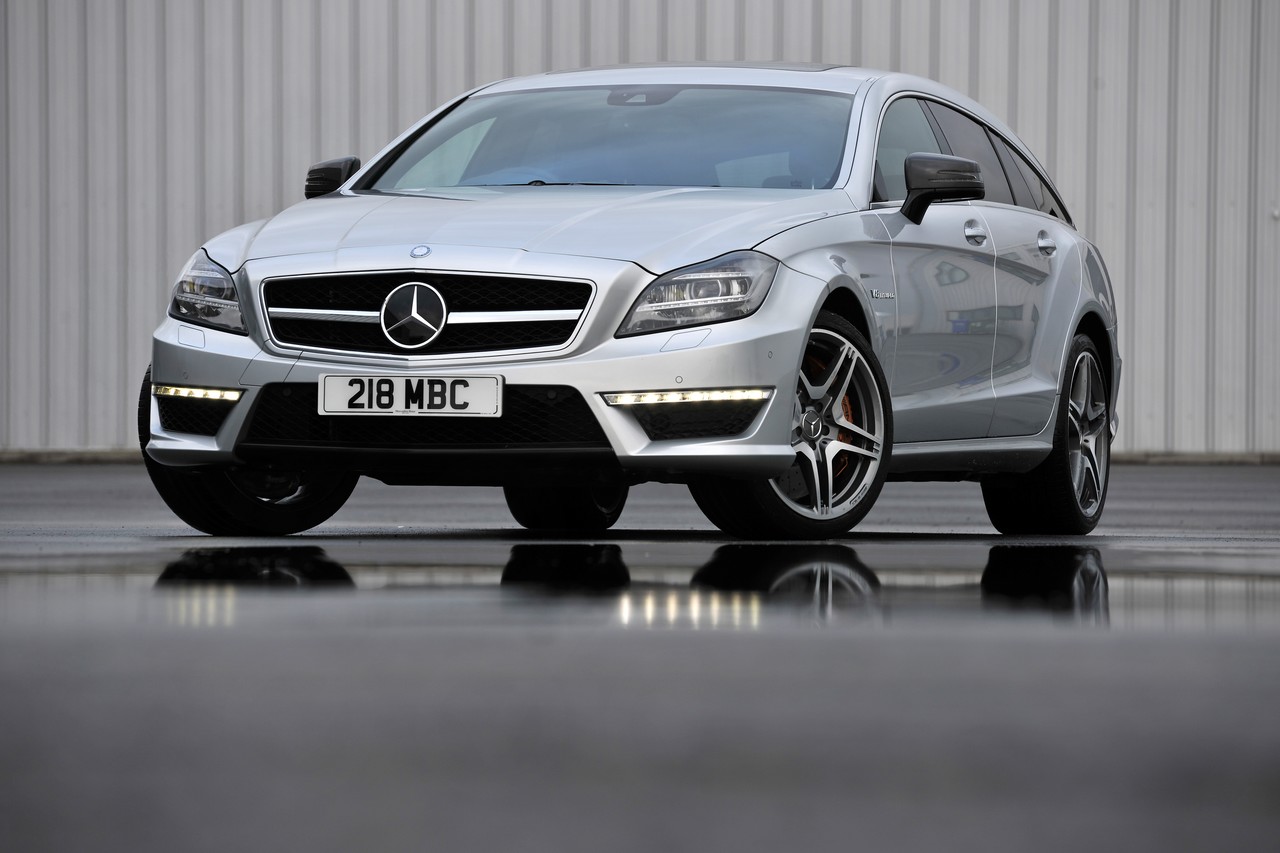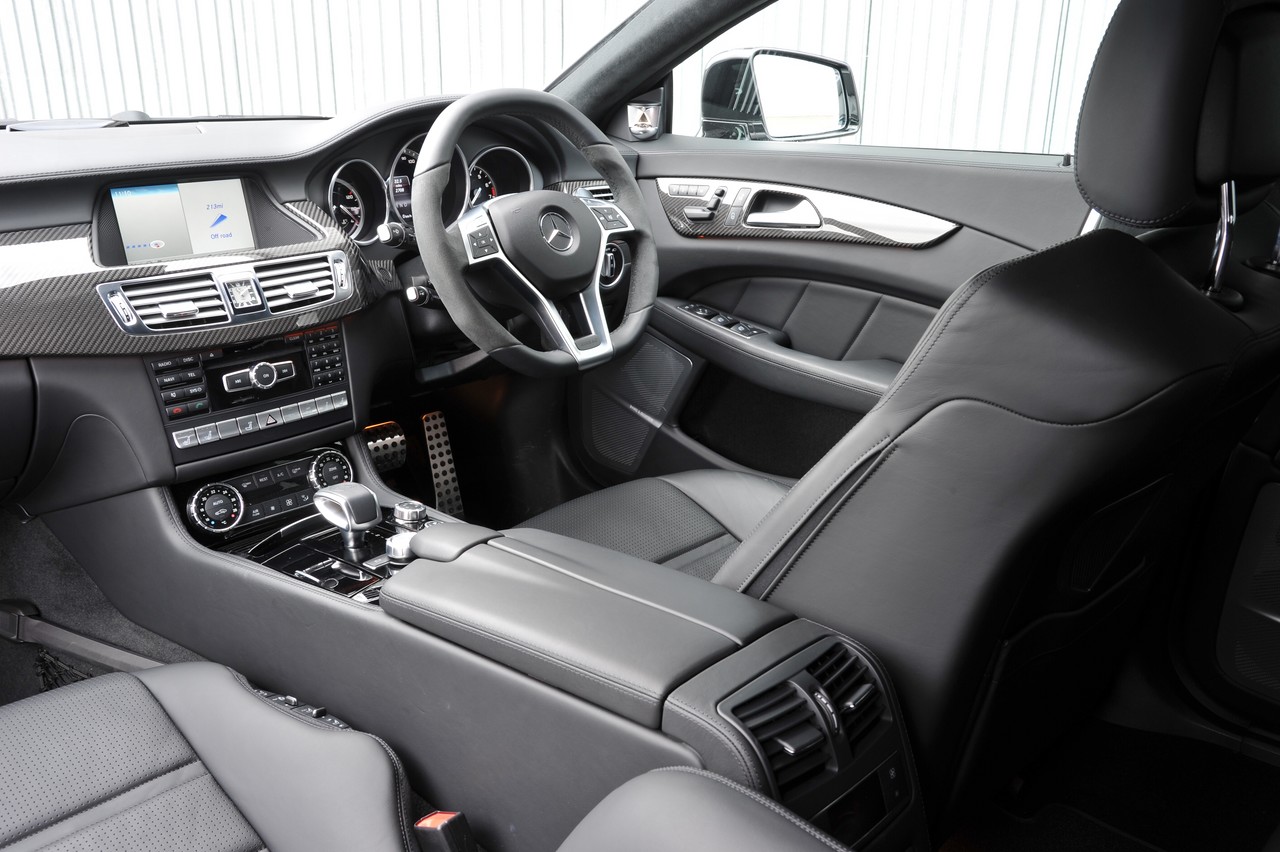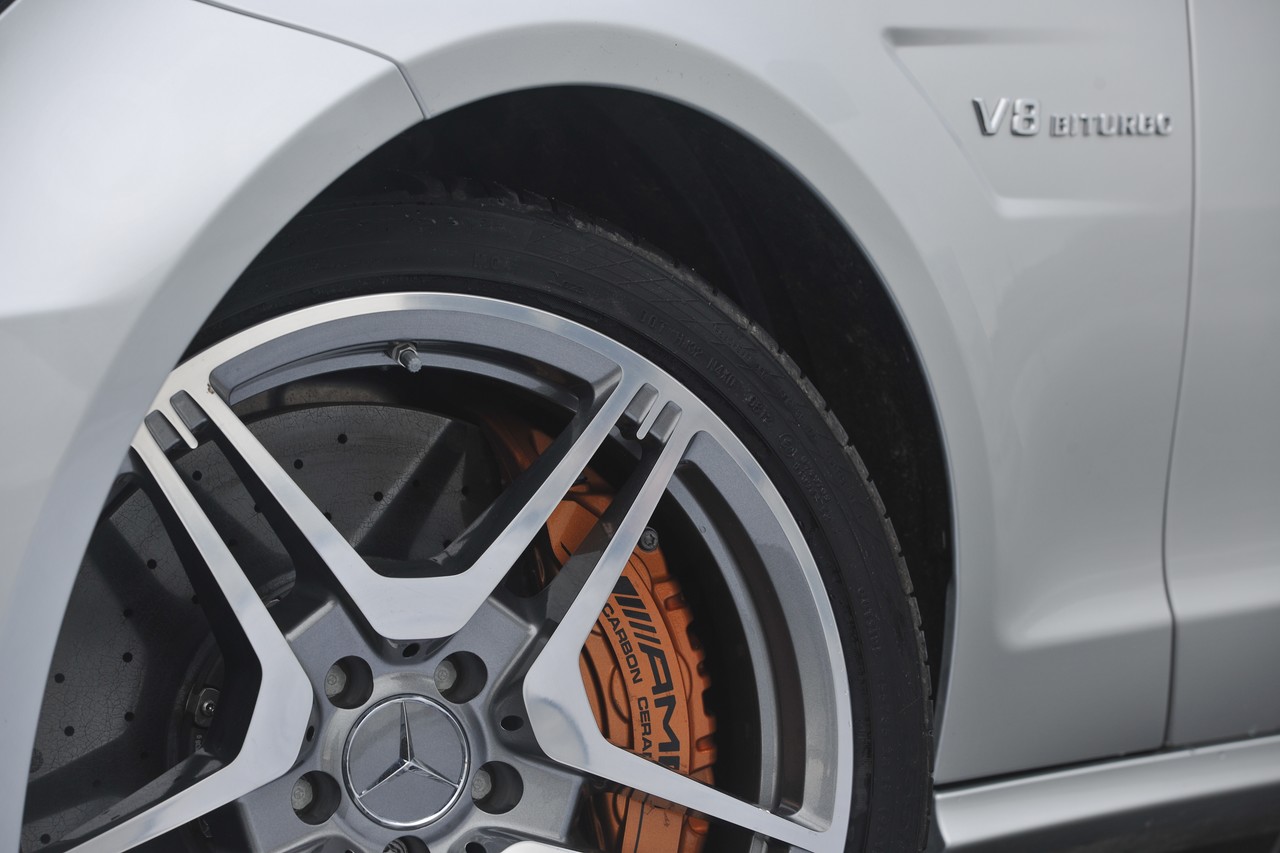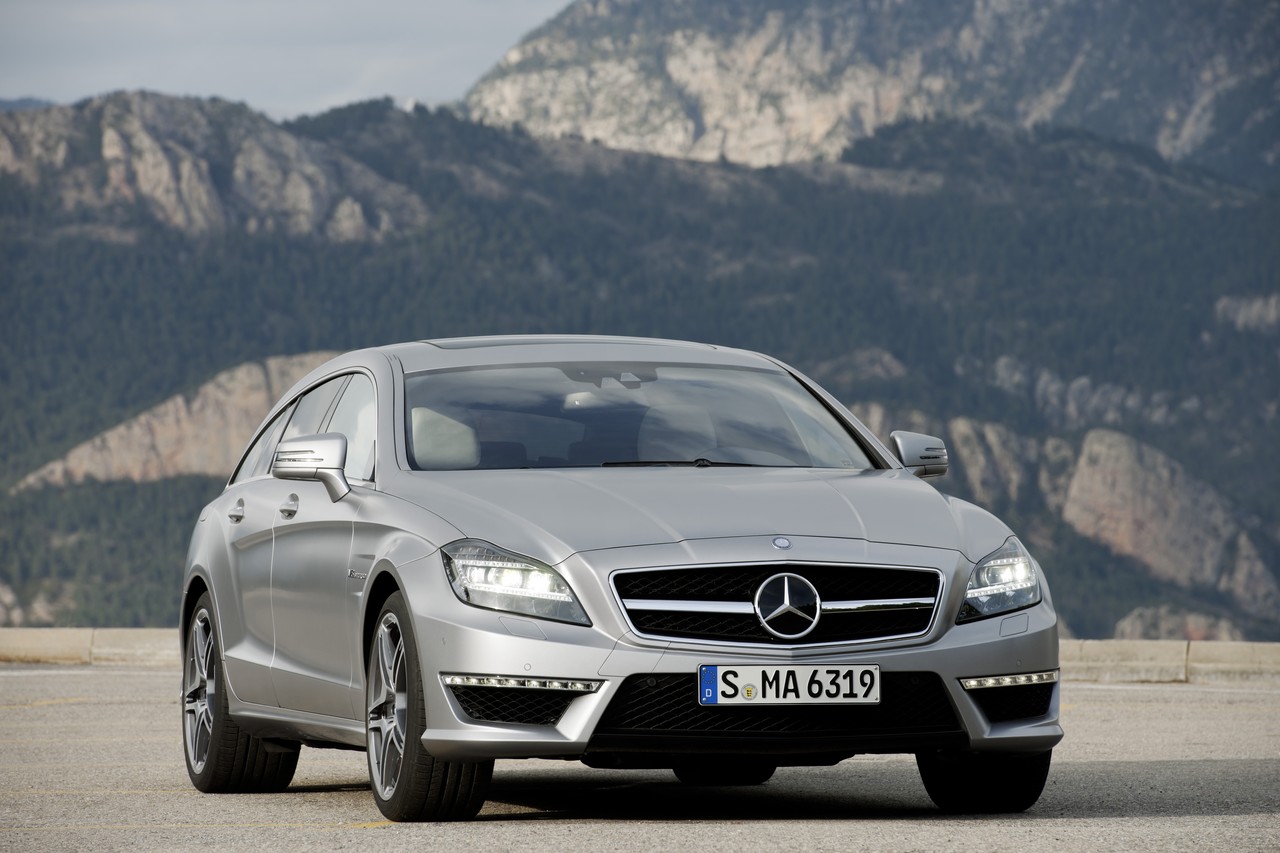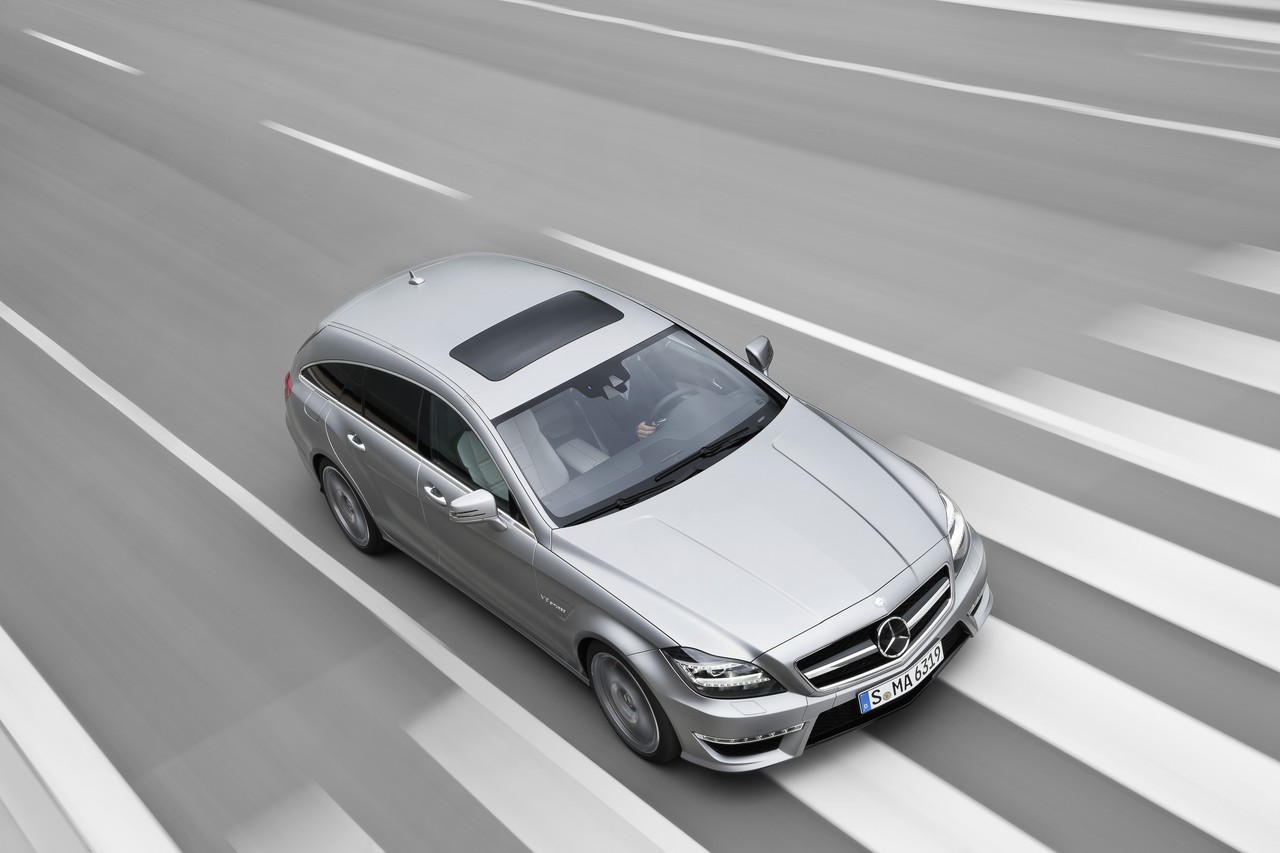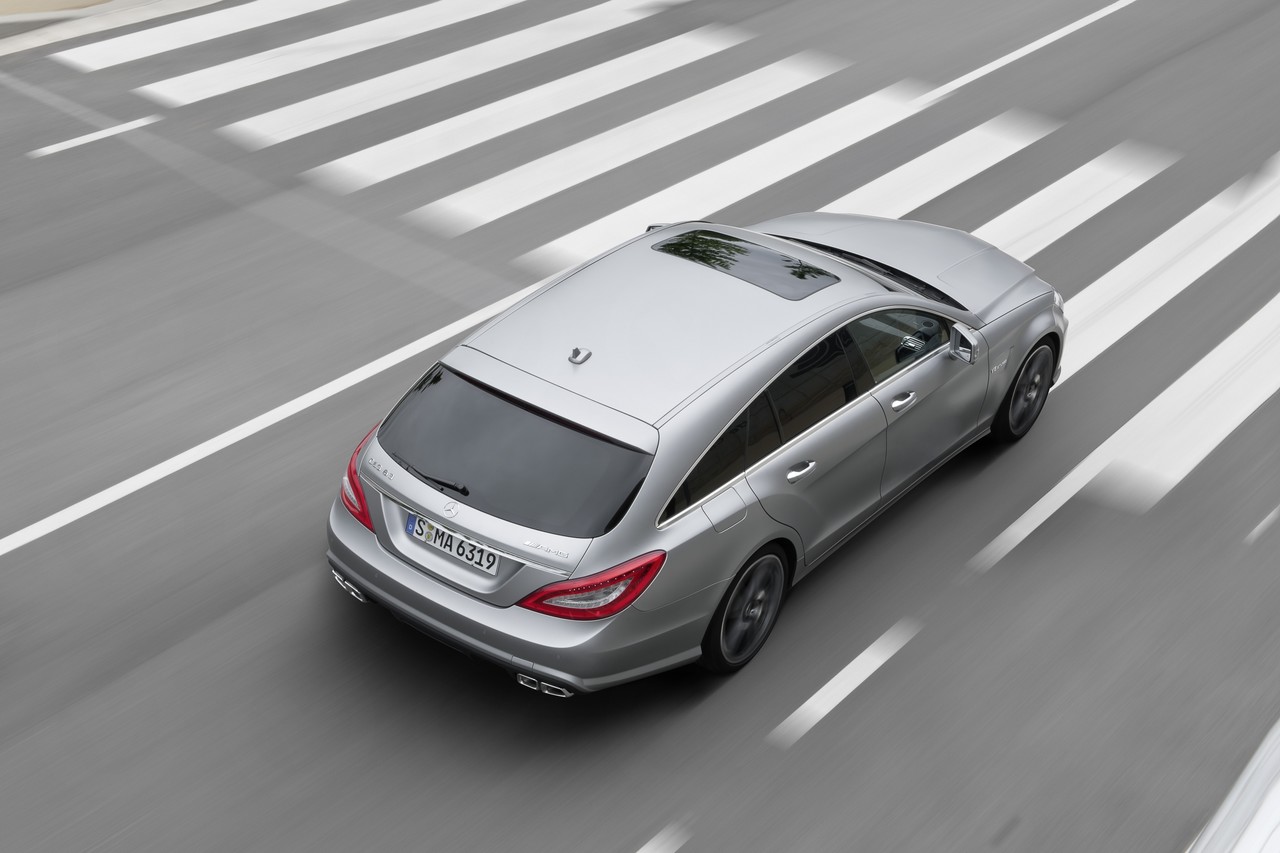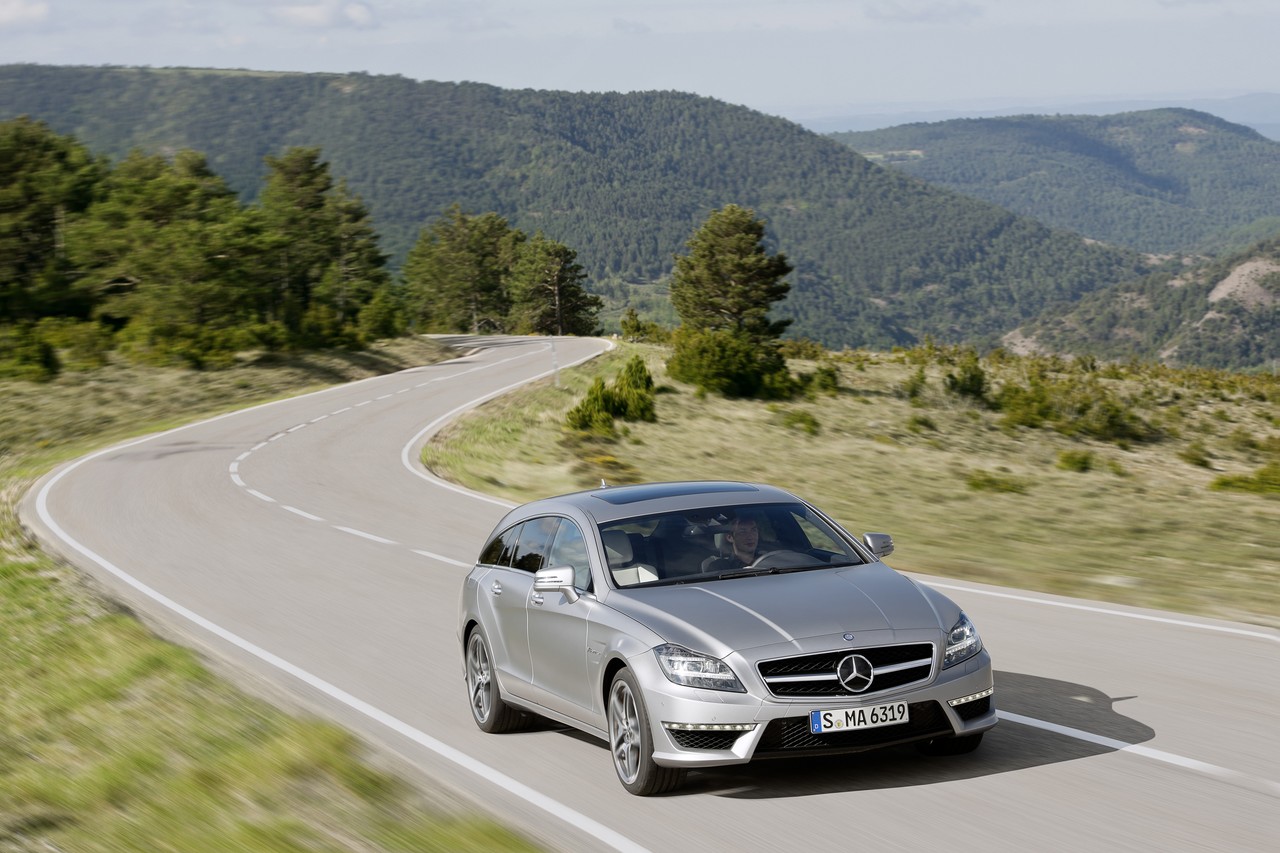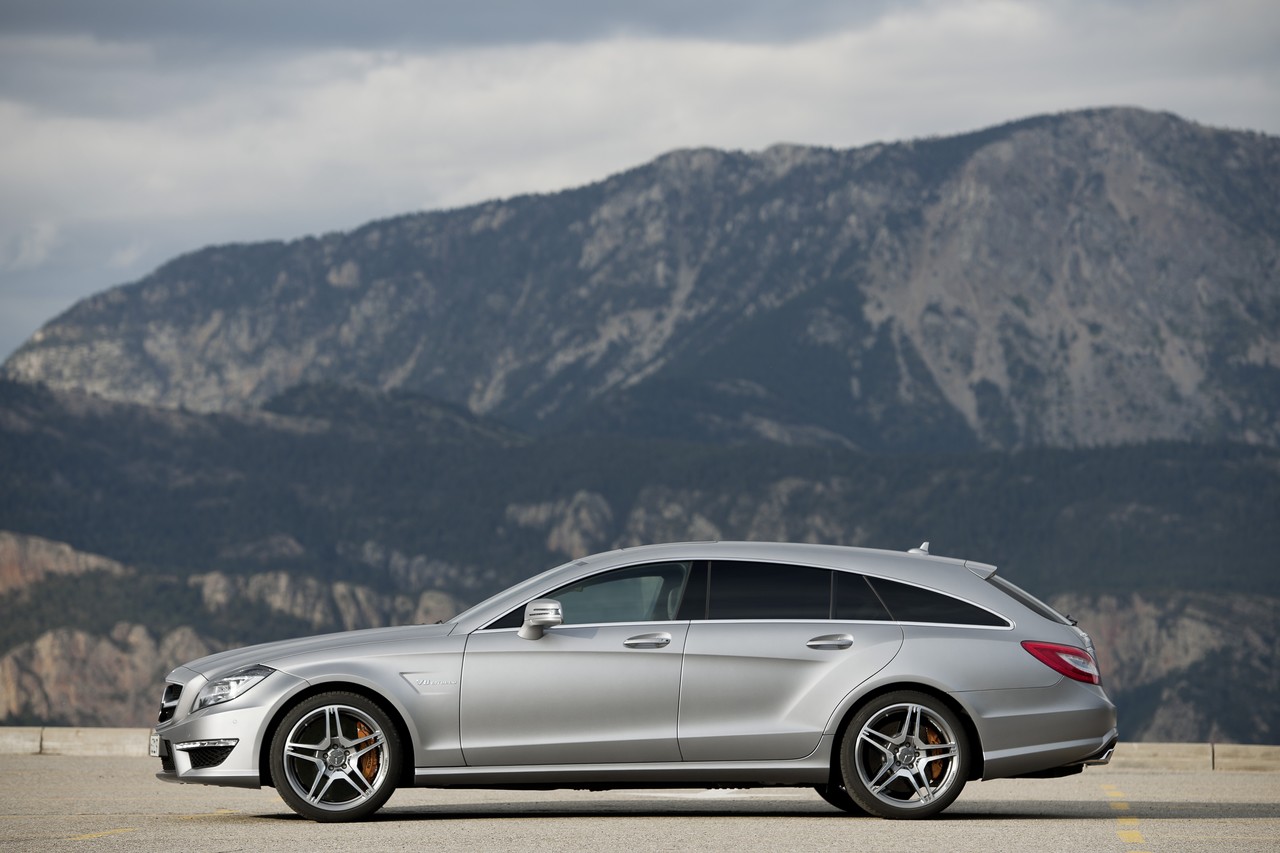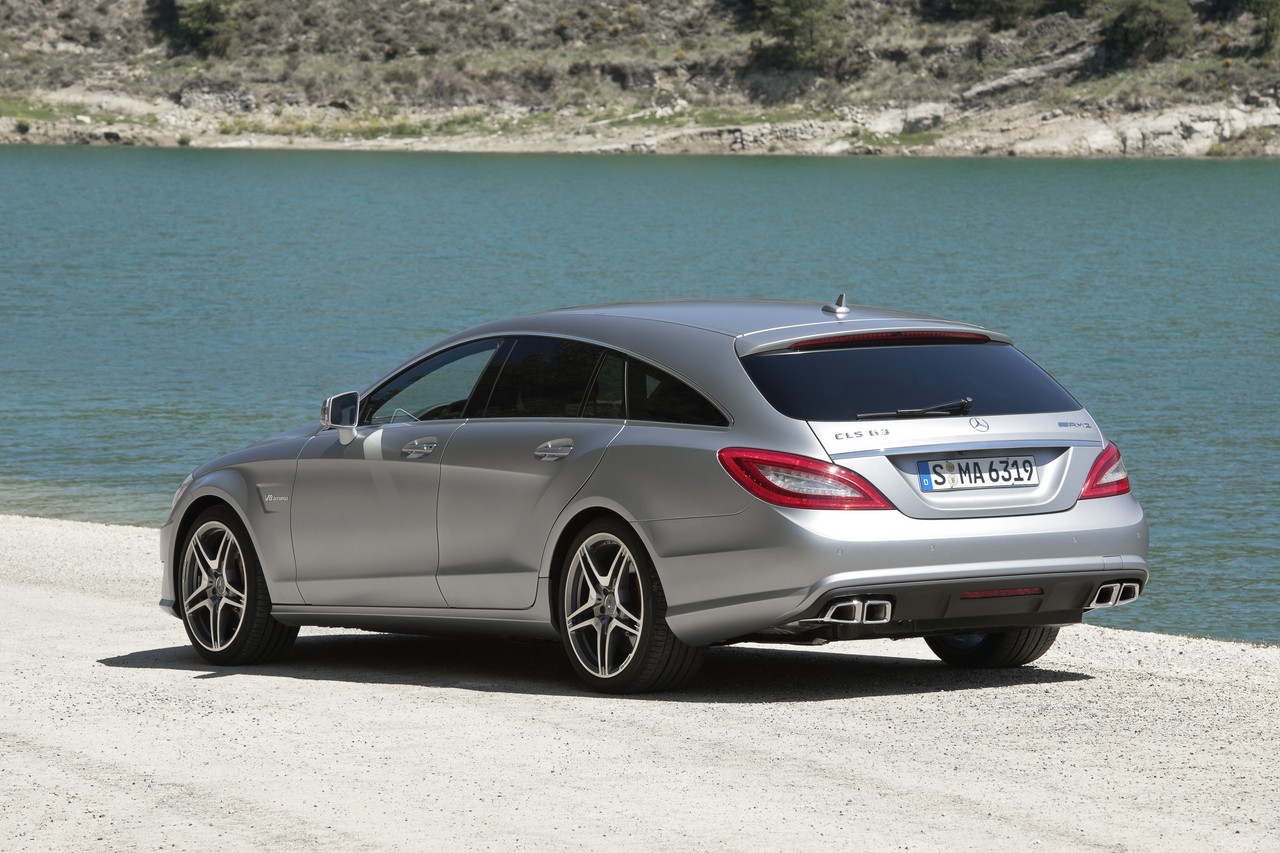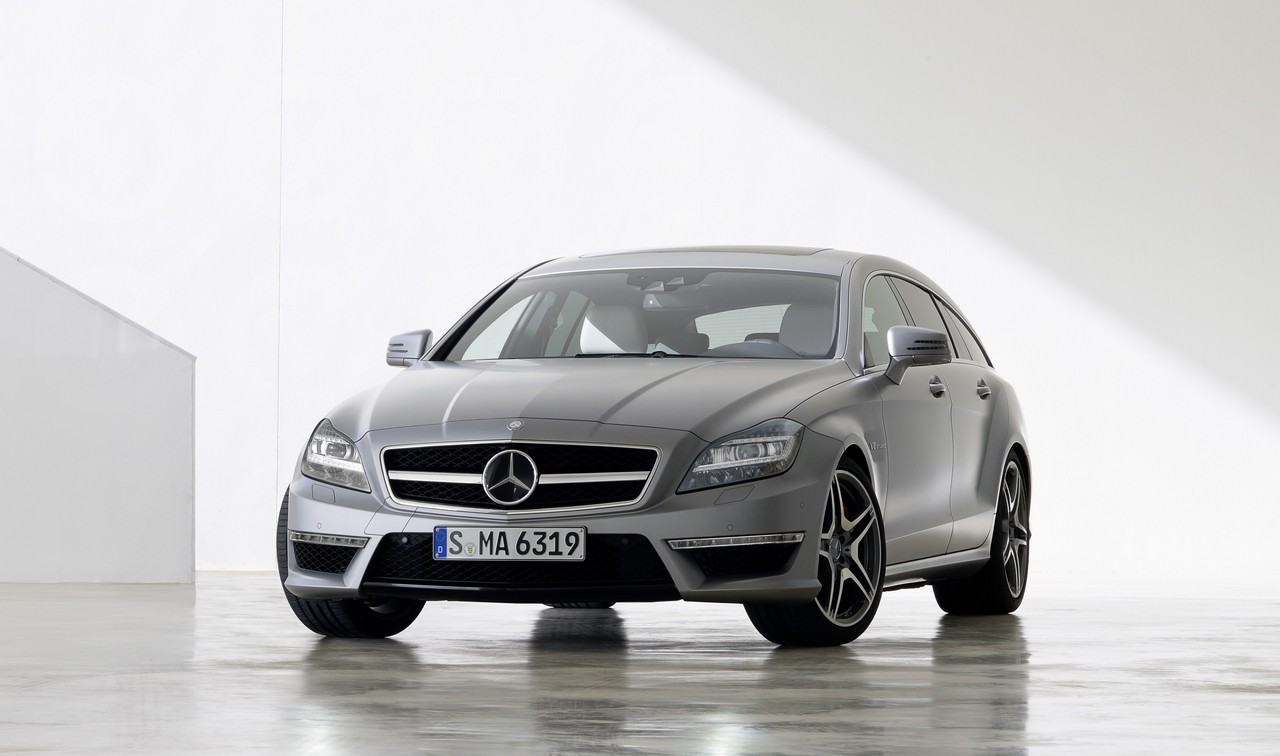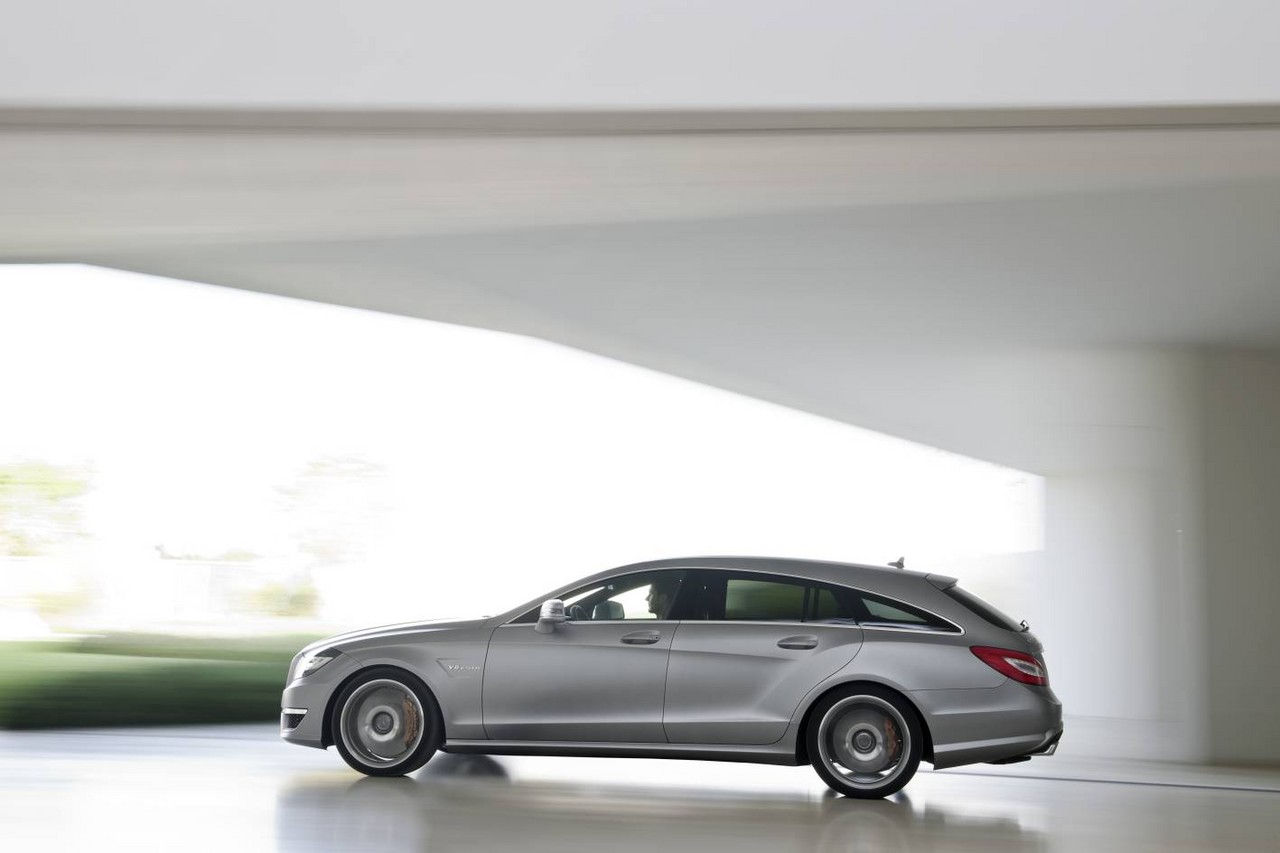
- Powerful 5.5-litre biturbo M157 V8 engine
- Excellent ride/handling balance
- Supportive front seats
- High standard of interior fit and finish
- Light steering is accurate…
- … but provides little feedback
- Suspension lacks low-speed compliance
- Real-world fuel consumption falls short of official figures
Overview
Released in Australia in October 2012, the Mercedes-Benz X218 CLS 63 AMG Shooting Brake was a five-seat wagon with a tapered roofline. Manufactured in Sindelfingen, Germany, the rear-wheel drive X218 CLS 63 AMG was powered by a 5.5-litre biturbo V8 petrol engine that was mated to a seven-speed semi-automatic transmission.
For Australia, the first five deliveries of the CLS 63 AMG Shooting Brake were the limited-production ‘Edition 1’. The standard CLS 63 AMG Shooting Brake was available in Australia from early 2013. The CLS 63 AMG S replaced the CLS 63 AMG in October 2013.
M157 biturbo V8 engine: 386 kW and 410 kW
The M157 V8 engine had an aluminium block with cast-in aluminium-silicon (Silitec) cylinder liners, forged crankshaft made of 38MnS6BY steel alloy (a combination of manganese, sulphur, boron and yttrium) with eight counterweights and rotating in five main bearings, fracture-split forged connecting rods, an aluminium cylinder head, double overhead camshafts (driven by three high-performance chains), variable intake and exhaust camshaft adjustment over a range of 40 degrees via four pivoting actuators, four valves per cylinder and a compression ratio of 10.0:1. Furthermore, the M 157 had a dry weight of 204 kg, maximum engine speed of 6400 rpm and Bosch MED 17.7.3 control unit.
Significantly, the M157 engine had spray-guided direct injection with piezo fuel injectors (operating at 100 to 200 bar on a demand-related basis), a Garrett turbocharger for each cylinder bank (welded to the exhaust manifold) and air/water intercooling. Of the turbochargers,
- For the 386 kW M157 engine, peak charge pressure was 1.0 bar; and,
- For the 410 kW engine in the CLS 63 AMG Edition 1, peak charge pressure was 1.3 bar.
For greater fuel efficiency, the M157 engine had an ‘ECO start/stop system’ – which the driver could disable if desired – and multi-spark ignition whereby the spark plugs could fire multiple times during the combustion sequence for more efficient combustion.
M157 biturbo V8 engine: 430 kW
For the CLS 63 AMG S, peak outputs for the M157 engine increased to 430 kW and 800 Nm. According to Mercedes-Benz , ‘[t]he technical basis for this uprating results from adaptation of the engine application, an increase in peak pressure and a rise in the charge pressure from 0.9 to 1.0 bar.’ This statement, however, is in conflict with Mercedes-Benz’s announcement when the M157 engine was first introduced that charge pressure was 1.0 and 1.3 bar for the standard and Performance Package engines, respectively.
AMG Speedshift MCT
The seven-speed ‘AMG Speedshift MCT’ (Multi Clutch Technology) had a compact, wet start-up clutch that operated in an oil bath rather than a conventional torque converter. The AMG Speedshift transmission had four individual driving modes which the driver could select via a rotary dial:
- Controlled Efficiency, ‘C’, enabled the ECO start/stop function, provided softer throttle response, accelerated from rest in second gear and provided early upshifts to minimise fuel consumption;
- Sport, ‘S’, for greater throttle response, higher engine speeds before upshifting and 25 per cent faster gearshifts. In Sport mode, the engine could partially suppress cylinder by interrupting ignition and injection under full load for faster gearshifts;
- Sport plus, ‘S+’, for 25 per cent faster gearshifts relative to Sport, with full throttle gearshifts completed in as little as 100 ms; and,
- Manual, ‘M’, for sequential shifting via the steering wheel gearshift paddles.
Other features of the AMG Speedshift transmission included:
- Automatic throttle-blipping on downshifts;
- A double-declutching function for multiple downshifts; and,
- A ‘Race Start’ function.
Gear ratios for the AMG Speedshift MCT were 4.34 (1st), 2.89 (2nd), 1.92 (3rd), 1.37 (4th), 1.00 (5th), 0.82 (6th) and 0.73 (7th); the final drive ratio was 2.65.
Performance and fuel consumption
The Mercedes-Benz X218 CLS 63 AMG Shooting Brake could accelerate from rest to 100 km/h in 4.4 seconds and had an electronically-limited top speed of 250 km/h. Over the combined ADR 81/02 test cycle, fuel consumption for the X218 CLS 63 AMG Shooting Brake was 10.3 litres per 100 km.
| Years | Engine | Trans. | Peak power | Peak torque | |
|---|---|---|---|---|---|
| CLS 63 AMG Edition 1 | 2012 | 5.5-litre bi-turbo petrol V8 (M157) | 7sp semi-auto | 410 kW at 5250-5750 rpm | 800 Nm at 2000-4500 rpm |
| CLS 63 AMG | 2013 | 5.5-litre bi-turbo petrol V8 (M157) | 7sp semi-auto | 386 kW at 5250-5750 rpm | 700 Nm at 1700-5000 rpm |
| CLS 63 AMG S | 2013-14 | 5.5-litre bi-turbo petrol V8 (M157) | 7sp semi-auto | 430 kW at 5500 rpm | 800 Nm at 1750-5000 rpm |
Dimensions and body
Compared to the related C218 CLS 63 AMG , the X218 CLS 63 AMG Shooting Brake was 4 mm longer (at 5000 mm), the same width (1881 mm), 6 mm taller (1412 mm) and had a 20 mm longer wheelbase (2874 mm); kerb weight increased by 85 kg to 1955 kg.
Cargo capacity for the CLS 63 AMG Shooting Brake was 590 litres, though this increased to 1550 litres when the rear seats were folded.
Suspension
The Mercedes-Benz X218 CLS 63 AMG had three-link front suspension with MacPherson struts and multi-link rear suspension. The suspension featured electronically-controlled dampers (‘AMG Ride Control’) which used sensors to measure drive and brake torque, steering angle, lateral acceleration, ride height, direction of motion and body roll, with the objective of reducing the roll angle of the body. Furthermore, the driver could select from three settings:
- Comfort: for soft damping characteristics;
- Sport: on average, 40 per cent firmer than Comfort; and,
- Sport plus: provided even higher damping resistance and used specific control algorithms for sporty driving.
The rear suspension included air springs that kept the rear of the vehicle at a constant height regardless of load (‘automatic level control’).
Compared to the X218 CLS Shooting Brake , suspension changes for the CLS 63 AMG Shooting Brake included:
- A unique front axle with a wider track (1625 mm);
- New front hub carriers for additional negative camber;
- New front wishbones, torque strut bearings and head bearings;
- A thicker front stabiliser bar; and,
- For the rear suspension, new track rods, push-pull rods and more rigid mountings for the subframe.
Steering
The Mercedes-Benz CLS 63 AMG Shooting Brake had electromechanical, rack-and-pinion steering which had a 14.0:1 (22 per cent more direct than the standard X218 CLS Shooting Brake); the degree of power-assistance varied according to vehicle speed and the selected suspension mode.
For the X218 CLS Shooting Brake, a ‘Steering Assist’ function was introduced for split friction surfaces whereby sensors would recognise impending yaw and the driver’s attempt to countersteer would be over-ridden.
Safety equipment
Standard safety equipment for the Mercedes-Benz X218 CLS 63 AMG Shooting Brake included dual front airbags, dual front pelvis airbags, a driver’s knee airbag, front and rear side airbags, full length curtain airbags, ABS, electronic brake force distribution, brake assist, electronic stability control, traction control, active front seat head restraints, driver fatigue monitoring (‘attention assist’) and seatbelts with pre-tensioners and load limiters for all seats.
The CLS-Class was also fitted with ‘Pre-Safe’, which anticipated and prepared for collisions by tensioning the seatbelts, adjusting the position of the front seats for optimal airbag deployment and closing the windows and sunroof (if open).
Active safety technologies for the CLS 63 AMG Shooting Brake included –
- Distronic Plus (adaptive cruise control with brake warning): an ‘adaptive’ cruise control system which used two short-range radar sensors positioned behind the front bumper to monitor the road up to 30 metres ahead, and a long-range radar located behind the radiator grille which had a range of 200 metres. Operating at speeds up to 200 km/h, Distronic Plus used an electronic control unit to analyse the information from both radar systems to calculate the engine, automatic transmission and braking parameters required for proximity control. As such, Distronic Plus could automatically apply the brakes to prevent the vehicle from becoming too close to traffic ahead (the time interval could be specified) and accelerate back to the set speed when traffic allowed. To accelerate from rest, the driver only needed to operate the Distronic stalk on the steering column or briefly depress the accelerator pedal. With Distronic Plus, automatic deceleration of up to four (4) m/s2was possible. If Distronic Plus detected that heavier braking was required, a warning light would illuminate in the instrument cluster and be accompanied by an audible warning. Furthermore, the electronic proximity control system could be activated independently of Distronic Plus at speeds over 30 km/h to alert the driver if they were approaching another vehicle too rapidly;
- Pre-Safe Brake (autonomous emergency braking): using two 24 GHz sensors behind the front bumper which had a range of 30 metres and a 77 GHz radar which had a range of 150 metres, Pre-Safe Brake operated at speeds between 30 km/h and 200 km/h, and at speeds below 70 km/h if the vehicle was approaching a stationary queue of traffic. Around 2.6 seconds before the anticipated moment of impact, an audible warning would sound and a red warning would appear in the tachometer. Around 1.6 before the calculated impact, the first stage of Pre-Safe Brake would initiate partial braking autonomously with around 40 per cent of the maximum braking power (approximately four (4) m/s2); the Pre-Safe occupant protections system would also be activated. If the driver then applied the brakes, maximum braking force would be made available. If the driver failed to react, Pre-Safe Brake would – in its second stage – initiate autonomous emergency braking (i.e. maximum braking power) around 0.6 seconds before the unavoidable collision to reduce the severity of the impact;
- Active Blind Spot Assist: automated braking of wheels on one side of the vehicle to prevent collisions with objects in the driver’s blind spot; and,
- Active Lane Keeping Assist: automated braking of wheels on one side of the vehicle to keep the vehicle within continuous lane markings.
Brakes: CLS 63 AMG Shooting Brake
The X218 CLS 63 AMG 360 mm by 36 mm composite front brake discs with six-piston callipers and 360 mm by 26 mm solid rear discs with four-piston callipers; both front and rear discs were internally ventilated and perforated.
As an extra-cost option, the X218 CLS 63 AMG Shooting Brake was available with a ceramic high-performance composite braking system which included 402 mm by 39 mm front brake discs and 360 mm by 32 mm rear discs.
Features: CLS 63 AMG and CLS 63 AMG S Shooting Brake
Standard features for the Mercedes-Benz CLS 63 AMG Shooting Brake included 19-inch AMG five tri-spoke alloy wheels (9.0J front and 10.0J rear), 255/35 R19 front and 285/30 R19 rear tyres, a Harman Kardon Logic7 surround sound system with fourteen speakers, a six-disc CD/DVD changer, MP3/WMA/AAC compatibility and auxiliary inputs (3.5mm/USB/iPod), COMAND APS (Cockpit Management and Data System) with a seven-inch colour display, HDD satellite navigation, voice recognition (‘Linguatronic’), 10GB hard drive, digital TV tuner, Bluetooth mobile phone connectivity and audio streaming, three-zone climate control air conditioning (‘Thermotronic’), AMG front seats with power adjustment and active multi-contour backrests, ‘Exclusive Passion’ leather upholstery with seat cushions in semi-aniline leather, cruise control with variable speed limiter (‘Speedtronic’), LED headlights, front fog lights, a reversing camera, front and rear parking sensors, automated parallel parking ‘Active Parking Assist’), an AMG steering wheel with gearshift paddles, remote central locking with proximity key, power adjustable mirrors with heating and folding functions, power windows, a power adjustable steering column (height and reach), memory settings (front seats, mirrors and steering wheel), a power-operated glass sunroof with tilt/slide function, an automatically dimming interior rear view mirror, push-button start (‘keyless go’), Alcantara roof lining, ambient lighting, , nappa leather interior trim (dashboard, beltline, armrests, head restraints, centre door panels and centre console), a power-operated rear window blind, brushed stainless steel sports pedals, AMG floor mats, 12 volt power outlets, tyre pressure monitoring, ash wood trims in high gloss black, piano black centre console trim, trip computer, ‘Racetimer’, motion-sensing alarm and an immobiliser.
The CLS 63 AMG Shooting Brake had LED head lamps and each headlamp contained 71 LEDs which had an estimated operating life of 10,000 hours – five times longer than xenon headlights. The headlights also utilised Mercedes-Benz’s ‘Intelligent Light System’ and ‘Adaptive High Beam Assist’.
The CLS 63 AMG S Shooting Brake was fitted with 19-inch AMG ten-spoke alloys and a rear axle differential lock as standard. Visual cues for the CLS 63 AMG included 19-inch AMG red-painted brake callipers and an AMG logo on the bootlid with an ‘S’ in contrasting black.
Mercedes-Benz X218 CLS 63 AMG Edition 1
Compared to the standard CLS 63 AMG, the Edition 1 was distinguished by its designo platinum white pearl leather appointments, designo roof liner in black ‘Dinamica’ microfibre and brushed stainless steel pedals. The Edition 1 models were also available with an exclusive designo magno allanite grey matt paint finish.
Brochure
Related links
- Press Kit: Mercedes-Benz X218 CLS Shooting Brake (September 2012)
- Specifications: Mercedes-Benz X218 CLS Shooting Brake (March 2014)
